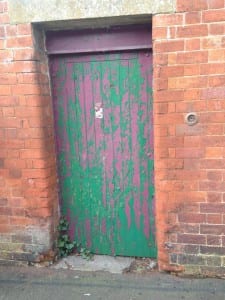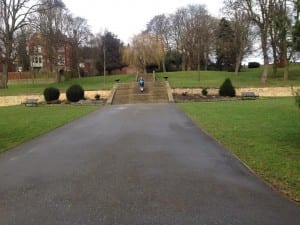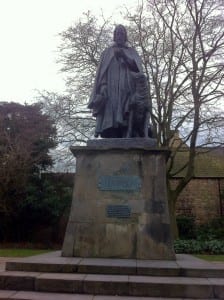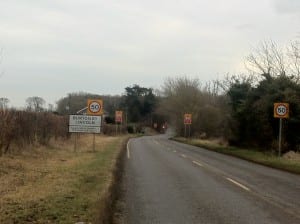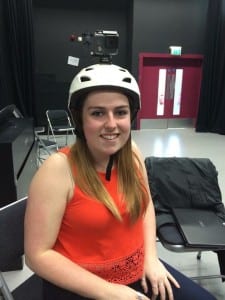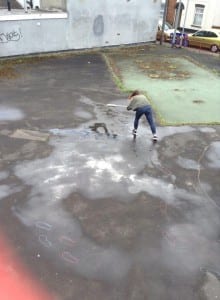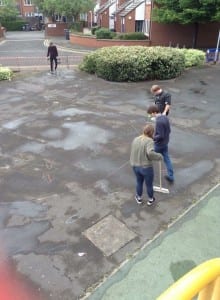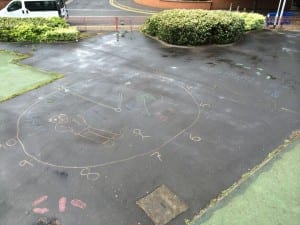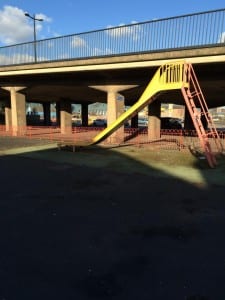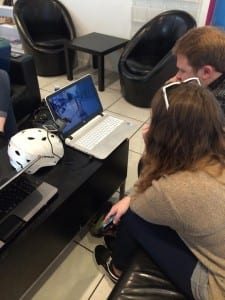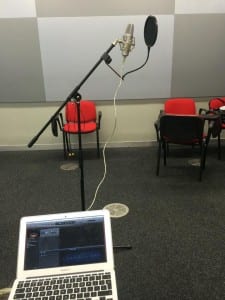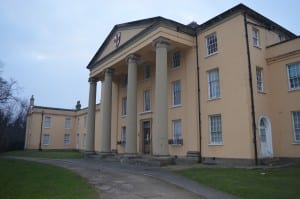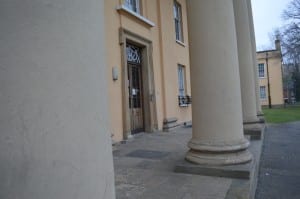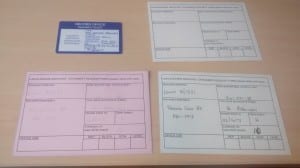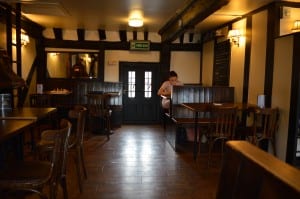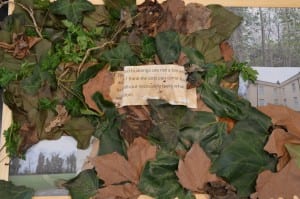Framing Statement
Our piece A Journey Through Time was the product of 12 weeks of work within a group consisting of Sara, Sarah, Lee, Emma, and I working within the Lincoln Arboretum to create a site specific performance. The Lincoln Arboretum is full of history and within this we ultimately decided to use a part of the history of the site which had no visible remnants left in the year 2015, that we were performing. This piece of history was the Cold Bath House, a council building that was unfortunately bombed during the second world war during an air raid. An account we used within our piece was an account by a child during the war Fred Hurt a part of this says “People tell me it was five o’clock when they looked up to see the bombs falling down. One of them hit Coldbath House and another landed on the allotments in St Anne’s Road.” (Hurt, 2005) We liked this idea due to the unknown nature of the house as; as much as we tried no member within the group could find a picture of the Cold Bath House in full glory.
World War II was such an influential part of the history within Lincolnshire that we felt compelled to include it within our piece. The air fields around the city made the county a target for the air raids going over England to be hit. So when we discovered that the Arboretum and World War II were intrinsically linked to each other. This gave encouragement to research further into the rich history that surrounded our site.
We took inspiration from a theatre company called Punchdrunk and their 2013 performance The Borough in Aldeburgh. “Punchdrunk’s 2013 performance The Borough in Aldeburgh is an audio led tour around the seaside town. Their piece like ours is based upon a piece of fiction, theirs a poem by George Crabbe, ours a book extract from The Timekeeper by Mitch Albom. This use of fiction creates a more mystical element, a piece of fiction around the everyday life. This parallel between fact and fiction is a common theme – intriguing multiple people including our group.
The Guardians review of The Borough states “Punchdrunk encourage you to look seawards, finding a place where the sky and sea, past and future, fact and fiction collide.” (Gardner, 2013) this idea of standing in a spot overlooking something and being asked to think is reminiscent of a point in our piece where we encourage our audience members to overlook and think about the affect of time. Punchdrunk’s piece has helped us develop our piece with its audio led piece, directing the audience through Aldeburgh as we are guiding our audience members through the Arboretum.” (Spindler, 2015)
Part of our performance was moulded strongly on the fact that we were outside in the Arboretum, we had no control over the weather. Our performance date given to us was the 7th May 2015 and the weather was predicted to be cloudy with intermittent rain. This was less than ideal as rainy weather affects peoples interpretations and moods within a space and having thought about our performance being in the sunshine due to the hope of it being May and not any winter months when the dress run of our piece happened in the pouring rain our group were concerned with if it was heavily raining during our performance. Thankfully, our performances managed to avoid the rain as it began after we had finished the audio tour with the audience members each time.
Analysis of Process
During our drift at the beginning of the semester we encountered the Arboretum in Lincoln, this park is a picturesque part of the City saturated with history and from the moment we stepped foot into the park we had unanimously decided that this would be our performance space for this module. At the top of the Arboretum when we had decided to head back into the City Centre we came across a door
Fig. 1 (Spindler, 2015)
This door intrigued us as it was abandoned and human nature having no idea where it led to it, introduced our first theme of our piece, the past. This first emerged as an idea to show a story of a couple from World War 2 and how his enlistment and then death affected their lives. However, we had taken our idea to literally and had taken it in a different direction than the module and tutor wanted for this so we were back to the drawing board and we briefly left the past behind to focus on the broader aspect of time. We briefly toyed with the idea of hello’s and goodbye’s within the park setting, but we could not adapt this idea to suit our group, nor fit in a site specific performance our performance would have been site generic at best. Fiona Wilkie states for a performance to be site specific, performers need to have “layers of the site [..] revealed through reference to: • historical documentation • site usage (past and present) • found text, objects, actions, sounds, etc • anecdotal guidance • personal association • half-truths and lies • site morphology (physical and vocal explorations of site)” (Wilkie, 2002, p.150) As a group, we took this into consideration and through research Sarah Cameron and Lee Meachen in our group discovered the history of the Cold Bath House that was located within the Arboretum, the beginning brick in our performance. Henry Hebb was a councilman from Lincoln who designed the Cold Bath House and had it built at the top of the Arboretum where it was used for the council. This past usage of the site was one of the factors that helped make our performance take on the ‘site specific’ route.
Writing the script was something Sarah Cameron and I undertook with Sarah Cameron writing the character monologues and I wrote the more reflective passages on the effects of time. We used a quote from the book called The Timekeeper by Mitch Albom, this was “Try to imagine a life without timekeeping. You probably can’t. You know the month, the year, the day of the week. There is a clock on your wall or the dashboard of your car. You have a schedule, a calendar, a time for dinner or a movie. Yet all around you timekeeping is ignored. Birds are not late. A dog does not check its watch. Deer do not fret over passing birthdays. Man alone measures time. Man alone chimes the hour. And because of this man alone suffers a paralyzing fear that no other creature endures. A fear of time running out.” (Albom, 2012, p.8) This quote was perfect for our piece as it encompassed our idea and more. By using this at the beginning and end of our piece it resembles a clock beginning and ending at the same point. By having this cyclical nature to the piece both within the performance and repeated performances throughout the day.
Writing the reflective passages I wanted the audience to focus on their own actions within their lives and how time affects this. We used repetitive actions to stand out in the space, although our outfits were chosen to blend into the setting. Lee Meachen was the only member to stand our slightly and that was for character work as he was playing Henry and as a group we decided that he should dress smartly for it to not juxtapose the audio for the audience. The idea of repetitive actions was to look like we were running on clockwork just doing the same thing again and again. This would jar with any members of the public who were in our site at the time as their movements would be unpredictable whereas ours where. This predictability and unpredictability reflects how human nature can often end up, with people living completely predictable lives and some people flourishing off spontaneity. By not knowing what the members of the public where going to do whilst in the park and around us, it had the potential worry of causing interference with our actions but also the freshness that every performance was new. The constantly changing surroundings showing how much the Arboretum has changed from the accounts heard via audio and how much it will change in the future.
Due to the nature of our piece we felt it best to have one audience member visit at a time so that they could focus on the audio and be fully immersed into our piece establishing a more focused aura to our piece as there was no aim to have the audience getting distracted by other people and due to it being incredibly hard to sync up media players to play an audio track at the same time and a minor second clash would have meant that audience members would be moving onto the next stage in our performance before the others they were with. Another benefit of only taking one audience member round at a time is due to the reflective passages within the audio it meant that they did not feel a pressure from anyone else to react in a certain way. The calmness that was the aim to induce felt more achievable by letting the audience member reflect on their own and peacefully walk around the site appreciating the aesthetics.
We ended our performance as these steps in the Arboretum that can be seen below:
Fig. 2 (Spindler, 2015)
The end point being here was chosen for aesthetic reasons as it is the centre point of the Arboretum and we wanted to end the piece in a memorable location. The stairs were a convenient place for all of the performers to gather in one place together for the first time, as if peoples stories where intermingling together to create a joined ending where everyone is united. This picturesque ending was intended to do just that, leave a final picture for the audience member to view. This had it so that both in the beginning and ending, the performance with a specific view of an object from doors to stairs.
Limitations to our Performance
Audio as a performance form caused a lot of limitations on our performance, as essentially half of our performance had to be pre-recorded and perfect before our performance and although it stops the panic of forgetting a line if something went wrong upon the day the audio would not be able to chance and from that point on there would be a juxtaposition between what was being seen and what was being heard. By using audio we were introduced to an audio editing program called Audacity, this program was easy to use once understood and I am pleased to have a new skill learnt from this experience. However, having audio as a non-optional part of our performance it was non-beneficial as any struggles with audio had to be overcome otherwise the performance would have not had a good outcome. Using audio limited our actions we could do at the park as we as performers could have no way of exactly pin-pointing the exact second that the audio was running to. This meant that the more character based individuals could not do any gestures at any specific point in time and had to create more general actions to do. By having these general actions there are points in a performance that could get lost such as interacting with audience as there is a headphone barrier between the two people.
Another limitation we had within this creative process was trying to make sure that our performance was site-specific. The changes between the stages of; outside theatre; site sympathetic; site generic; and site specific are thin lines which can easily get muddled up. The consequences of mixing these up would have ended the module with a performance that did not efficiently reflect the learning criteria. This focus on making a performance site specific meant that we were narrowed down the options that we could undertake. This focus on the nature of site specific at points became a ground point for our group as there was one point when the ideas within the group were too clashing and we had to discuss whether to divide into two groups or to stay as one. Ultimately we found a way to combine our ideas making it a site specific piece that was not too focused on characters yet it was not site generic and therefore the group managed to meet in a satisfactory middle point.
Performance Evaluation.
On reflection I think our performance went smoother than expected but there were still improvements we, as a group, could have done. Our interaction was lacking due to a choice we had made to have the audience observe and not participate, however the performance in hindsight would have been more influential if we had asked the audience to partake in the performance. A great spot for this to have happened would have been in the section where the audience were looking at the maze in the Arboretum. It was unfortunate but, it would have worked exceedingly well to have had the audience get ‘lost in the maze’ and therefore ‘lost within time’ and if we were to edit and perform our piece again this is an aspect I would be sure to add within the audio.
Another edit I would have made to the performance would have been to remove the ‘play park’ part of the performance and replaced it with another option. In my personal opinion the ‘play park’ was the weakest part of the performance and it did not have the feel to it I originally intended when writing the script. That part however was out of my control and it did not give off a good impression considering how it was the middle of our performance and to dip in any part of a piece is regrettable and unsatisfactory.
An additional audience interaction moment I would include next time would be based off Lee’s action in the performance and have the audience join him with drawing the Cold Bath House asking them to draw the building where it should have been in amongst the landscape of the Arboretum. This would have added a nice touch, by having them access their imagination and contribute to the site and performance.
A regrettable aspect of our performance was a difficulty within obtaining audience members. The assessors were the only people to come to the performances and due to a lack of interest and clashing with other site specific performances no one else came to view our piece. This defeated morale slightly and meant we could not complete the day we were intending on doing as we originally wanted to do seven performances between the hours of 11-5:15 and have one performance every hour excluding one hour so that the group would be able to get lunch. However we only performed at the hours of twelve and three leaving a huge gap in the middle where we could have performed but were unable too. Although this ultimately helped as the weather went sour after our performance at three o’clock and it would have been completely unsuitable weather to perform in both for performers and audience members.
Overall, the theme of time and accounts from the Arboretums past blended in to each other in a well-suited manner. With our first experience of using audio as our main means of performance I am content with what we as a group produced. Our first experience with Audacity caused us to have complications that we did not expect, for example, the sheer amount of wind background noise you record when recording anything in an outside space. This is one of the main things I wish I could have changed, which is to have a clearer recording for our audio as I felt certain areas within the audio demonstrated our lack of expertise within the field. Some vocal parts showed an inexperienced nature, with some bits sounding stilted and non-flowing. However, this was again an unavoidable part of having a group with members having never recorded audio for a performance. The main changes I would make to our performance would be to rerecord all the audio to try an achieve a higher standard of work, and within the Arboretum actually have our audience members give more of a contribution to our piece by interacting with us as performers in the site and actually going into the maze instead of passively observing it from the outside.
Bibliography.
Albom, M. (2015) The Timekeeper. London: Sphere.
Gardner L. (2013) The Borough – Review. The Guardian, 11 June. [Available from: www.theguardian.com/stage/2013/jun/11/borough-review]
Hurt, F. (2005) Memories of Wartime Lincoln Part 3. [online] Lincoln: BBC. Available from: http://www.bbc.co.uk/history/ww2peopleswar/stories/10/a7503310.shtml [Accessed 11th May 2015]
Spindler, H. (2015) Fig. 1 [photograph]
Spindler, H. (2015) Fig. 2 [photograph]
Spindler, H. (2015) My City of Lincoln Story Punchdrunk’s influence on our piece. [blog entry] 21 April. Lincoln: Available from: https://sitespecific2015ksa.blogs.lincoln.ac.uk/2015/04/21/punchdrunks-influence-on-our-piece [Accessed 12th May 2015]
Wilkie, F. (2002) Mapping the Terrain: a Survey of Site-Specific Performance in Britain. New Theatre Quarterly, 18 (2) pp.140-160
